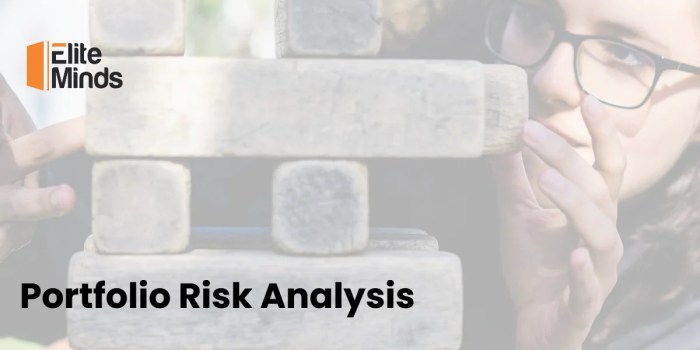Yo, peeps! So, let’s dive into the world of portfolio risk analysis, where we break down those numbers and risks to help you navigate the financial jungle like a boss. Get ready for some serious insights and tips that will level up your investment game!
Now, let’s get into the nitty-gritty of what portfolio risk analysis is all about and how you can use it to make informed decisions.
Fundamentals of Portfolio Risk Analysis

Portfolio risk analysis is a crucial process in the world of finance that involves assessing the potential risks associated with a portfolio of investments. By analyzing various factors, investors can make informed decisions to manage and mitigate these risks effectively.
Key Components of Portfolio Risk Analysis
- Market Risk: This type of risk arises from fluctuations in the overall market, impacting the value of investments across the board.
- Credit Risk: Refers to the possibility of loss due to the failure of a borrower to repay a loan or meet contractual obligations.
- Interest Rate Risk: Relates to the potential impact of interest rate changes on the value of fixed-income securities within a portfolio.
- Liquidity Risk: Involves the risk of not being able to buy or sell an investment quickly enough without significantly affecting its price.
Examples of Different Types of Risks in Portfolio Risk Analysis
- Political Risk: Fluctuations in government policies or regulations that can impact the value of investments in certain industries or regions.
- Currency Risk: The risk of loss due to changes in exchange rates when investing in foreign assets.
- Systematic Risk: Also known as market risk, it refers to risks that affect the entire market and cannot be diversified away.
Quantitative Methods for Portfolio Risk Analysis
When it comes to analyzing portfolio risk, quantitative methods play a crucial role in providing investors with valuable insights into the potential risks associated with their investments. Let’s dive into some common quantitative techniques used in portfolio risk analysis and how they are utilized.
Value at Risk (VaR)
Value at Risk (VaR) is a widely used method for estimating the potential loss in value of a portfolio over a specified time horizon and at a given confidence level. It provides a single number that represents the maximum amount that a portfolio is expected to lose under normal market conditions. This allows investors to better understand the downside risk associated with their investments.
Monte Carlo Simulations
Monte Carlo simulations are another popular quantitative technique used in portfolio risk analysis. This method involves running multiple simulations of possible future outcomes based on various input parameters. By generating a large number of scenarios, investors can assess the range of potential outcomes and the likelihood of different risk levels. This helps in making more informed investment decisions by understanding the uncertainty and variability in portfolio returns.
Statistical Measures: Standard Deviation and Correlation
Standard deviation is a statistical measure that quantifies the amount of variation or dispersion of a set of values. In portfolio risk analysis, standard deviation is used to measure the volatility of returns. A higher standard deviation indicates a higher level of risk associated with an investment.
Correlation, on the other hand, measures the relationship between the returns of two assets. Positive correlation means that the assets move in the same direction, while negative correlation implies they move in opposite directions. By analyzing correlations between different assets in a portfolio, investors can diversify their investments effectively to reduce overall risk.
Qualitative Factors in Portfolio Risk Analysis
When it comes to assessing portfolio risk, quantitative analysis is not the only player in town. Qualitative factors play a crucial role in understanding the full scope of risk that a portfolio may face. These factors provide valuable insights that numbers alone cannot capture.
Importance of Qualitative Factors
Qualitative factors help investors and analysts gain a deeper understanding of the underlying risks associated with a portfolio. They provide context and nuance to the numbers, allowing for a more comprehensive risk assessment. Without considering qualitative factors, the risk analysis may be incomplete and lead to potentially disastrous investment decisions.
- Market Conditions: The overall market environment, including volatility, liquidity, and investor sentiment, can greatly influence portfolio risk. Sudden shifts in market conditions can lead to unexpected losses or gains.
- Industry Trends: Understanding the trends and dynamics within specific industries can help assess how vulnerable a portfolio is to sector-specific risks. Emerging trends or disruptions can impact the performance of certain investments.
- Regulatory Changes: Changes in regulations or policies can have a significant impact on the risk exposure of a portfolio. Compliance risk is a key consideration for investors, as failing to adhere to regulations can result in financial penalties or reputational damage.
Portfolio Diversification and Risk Management
Diversification is like having a squad of different types of assets in your portfolio so that if one of them messes up, the others got your back. It’s like not putting all your eggs in one basket, ya know?
Role of Diversification in Managing Portfolio Risk
Diversification helps spread out the risk across different investments. So, if one investment goes south, the others can help balance it out and minimize the impact. It’s all about not putting all your money in one place and being smart about it.
Asset Allocation Strategies in Reducing Risk
Asset allocation is like deciding how much of your money goes into different types of investments, like stocks, bonds, or real estate. By diversifying your assets based on your risk tolerance and goals, you can reduce the overall risk in your portfolio. It’s all about finding the right mix that works for you.
Risk-Adjusted Returns in Portfolio Risk Management
Risk-adjusted returns take into account the level of risk you took to achieve a certain return. It’s like looking at how much you gained compared to how much risk you had to bear. This helps you evaluate if the return was worth the risk you took, and it’s a key factor in managing your portfolio effectively.
